Choosing the perfect tractor for a small farm goes beyond simply picking the most powerful machine. Each farm has its own unique set of challenges, from uneven terrain and tight fence lines to diverse crop requirements. With the right mix of horsepower, maneuverability, and attachments, a compact workhorse can handle planting, hauling, mowing, and more. This guide explores key factors, must-have features, top models, and practical maintenance tips to help you make an informed decision.
Selecting the Right Tractor Size and Horsepower
Assessing Land Requirements
Before diving into specs, evaluate your acreage and soil conditions. A 15- to 30-acre plot with mostly flat ground may only require a 20 to 30 HP unit, while hilly or rocky terrain often demands a bit more grunt to maintain consistent traction. Keep in mind narrow pathways, tree-lined orchards, and barnyard obstacles where compactness can be just as important as raw power.
Understanding Horsepower Ratings
Horsepower indicates a tractor’s pulling capacity, but real-world performance depends on transmission efficiency and weight distribution. Sub-compact tractors usually offer 15–25 HP, compact models range from 25–50 HP, and utility tractors span 50–100 HP. For most small-scale vegetable plots or livestock operations, a 25–40 HP tractor hits the sweet spot, striking a balance between efficiency and capability.
- Sub-Compact: Ideal for mowing, light tilling, and loader work in tight spaces.
- Compact Utility: Offers versatility for plowing, harrowing, and hay baling.
- Utility: Suited for heavier implements and moderate towing on mixed-use farms.
Essential Features and Attachments
Loaders and Backhoes
A front-end loader transforms your tractor into a material-moving powerhouse. Look for quick-attach systems that reduce downtime when switching between buckets, pallet forks, or bale spears. If you frequently dig post holes or clean ditches, consider a dedicated backhoe attachment designed for compact tractors, ensuring sufficient hydraulic flow and stability.
Mowers, Tillers, and Other Implements
Versatility stems from a well-chosen set of implements. Rotary cutters or finishing mowers keep pastures and lawns tidy, while box blades and rotary tillers prepare seedbeds with minimal effort. A three-point hitch with adjustable lift arms and a Category 1 quick-hitch makes swapping tools fast and safe.
- Tiller: Prepares soil for planting by mixing and aerating.
- Backblade: Ideal for grading driveways and leveling land.
- Flail Mower: Reduces brush and small saplings without clogging.
- Post-Hole Digger: Speeds up fence installation and tree planting.
Top Tractors for Small Farms
Sub-Compact Tractors (15–25 HP)
Sub-compact models excel in tight quarters, offering ease of storage and low ground pressure. Key contenders include:
- John Deere 1 Series: Known for its ergonomic controls and reliability.
- Kubota BX Series: Offers strong hydraulics and a smooth hydrostatic transmission.
- New Holland Boomer 20: Features a comfortable operator station and quick-attach loader.
Compact Utility Tractors (25–40 HP)
For moderate towing and heavier implements, these models deliver more versatility without sacrificing agility.
- Massey Ferguson 1700E Series: Combines fuel efficiency with a durable build.
- Kioti CS Series: Offers four-range hydrostatic gears and optional cab for all-season use.
- Mahindra 2550: Popular for its robust hydraulics and high lift capacity.
Utility Tractors (40–60 HP)
While at the upper end of small-farm tractors, 40–60 HP machines tackle heavier harvest implements, hay balers, and front-end loaders loaded with gravel or manure.
- Case IH Farmall Compact: Provides excellent stability on sloped fields.
- John Deere 4 Series: Known for its modular design and easy service access.
- New Holland Workmaster: Balances comfort, power steering, and operator visibility.
Maintenance Tips for Longevity
Routine Inspections
Regular checkups keep downtime to a minimum. Inspect for loose bolts, worn belts, and cracked hoses. Ensure hydraulic lines are free from leaks, and always carry spare filters to avoid lengthy delays during filter changes. A clean air filter preserves engine life by preventing dust from disrupting internal components.
Fluid Management
Fresh oil, clean fuel, and correct coolant levels are essential. Many manufacturers recommend oil changes every 100 hours, but in dusty environments, you may opt for a 50-hour interval. Use high-quality hydraulic fluid to maintain consistent performance in both loader and implement circuits.
- Engine Oil: Replace based on hours and recommended grade by the manufacturer.
- Hydraulic Fluid: Monitor color and viscosity; contaminated fluid reduces efficiency.
- Coolant: Check antifreeze concentration for year-round frost and boil protection.
- Fuel Filters: Change frequently to avoid injector blockage and preserve power output.
Seasonal Care
At the end of each season, thoroughly clean implements to prevent rust. Grease all zerk fittings and consider a rust-inhibiting spray on exposed metal. Store tractors under cover whenever possible, or use a high-quality protective tarp. Before the first spring task, charge the battery fully and test lights and safety switches.
Driving Tips and Operator Comfort
Ergonomic Controls
Look for tractors with adjustable seats, tilt steering, and well-placed pedals to reduce operator fatigue. Some models feature an easy-reach joystick for loader operation, while others include color-coded levers to streamline implement hookup.
Safety Considerations
Always engage the parking brake before leaving the seat and lower all implements to the ground when not in use. Ensure the ROPS (rollover protective structure) is locked in place, and consider a seatbelt equipped model. Proper lighting and reflective markings enhance visibility for early morning or late evening work.
- Visibility: Clear sightlines to implements, wheels, and attachment points.
- Noise Reduction: Cab models often offer quieter operation and climate control.
- Vibration Damping: Suspension seats and rubberized mounts reduce wear on the operator.



